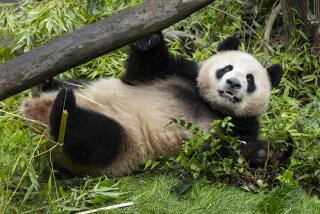Record Number of Penguins Hatch at Sea World
- Share via
More than 45 penguin chicks representing five different species hatched at Sea World this winter, setting a record for San Diego’s marine-life park, which runs one of the most extensive penguin breeding programs in the world, Sea World announced this week.
Although Sea World has successfully hatched eight species of penguin, this is the first time five species have been hatched in one season, Sea World spokesman Daniel LeBlanc said.
About 1,000 birds have hatched in Sea World’s climate-controlled rookery since it opened in 1983. The exhibit, called “Penguin Encounter,” is home to about 300 cold-weather penguins. The rookery mimics an Antarctic environment complete with computerized lighting cycles, icebergs, seawater and well-below-freezing temperatures.
Inside the rookery beginning in November, the Adelie penguin laid eggs on nests built of rocks. The king penguin incubated eggs one at a time, resting an egg on its feet under a loose fold of abdominal skin.
Outside the rookery, warm-weather Humboldt penguins laid eggs in burrows. Aviculturists removed and incubated many of these eggs to ensure some would hatch, since the bird is the only penguin listed internationally as an endangered species. Some of the chicks are being raised by hand, and some are being raised in the steady temperatures of the underground environment by their parents.
“Sea World’s colony is the most prolific of any Humboldt colony outside the wild,” according to a statement by Frank Twohy, Sea World’s curator of birds.
Aviculturists were especially excited when the first macaroni penguin to be hatched at the park emerged from its shell on Halloween. The cold-weather penguin, named “Spook” for its birthday, was being raised by hand and will rejoin adult macaronis in the rookery in a couple of months.
Another cold-weather penguin, the gentoo, also successfully reproduced this season.
“Every year,” Twohy said in the statement, “we increase our knowledge of penguin propagation--base-line research with definite applications to the conservation of these animals in the wild.”
Several more eggs were expected to hatch by the end of the month, closing out the breeding season.
Visitors to “Penguin Encounter” can see the baby chicks “if they are persistent and watch closely,” LeBlanc said, adding that most of them will be full grown in three months.
More to Read
Sign up for Essential California
The most important California stories and recommendations in your inbox every morning.
You may occasionally receive promotional content from the Los Angeles Times.










